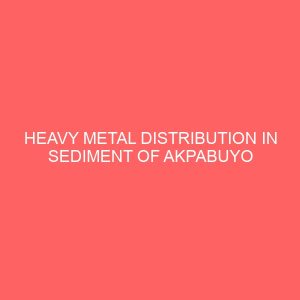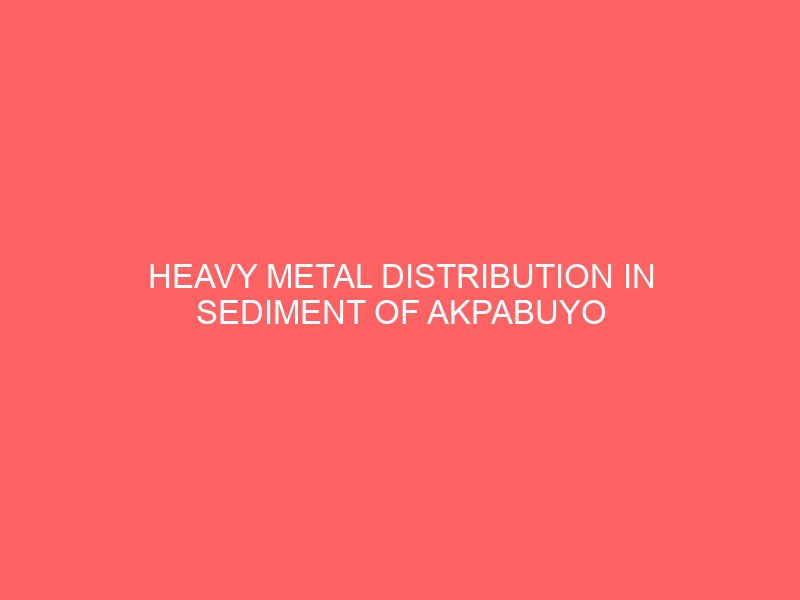Description
ABSTRACT
Sediment samples were collected through the purposive sampling method from various streams in Akpabuyo L.G.A, ten sample location were selected. The concentration and areal distribution of selected metals (Fe, Zn, Mn, Cr, Ni, Co, Cu, Cd, Pb) in the sediments of Akpabuyo streams .Geo-accumulation index have been calculated to assess whether the concentrations observed represent background or contamination levels. It proves that the choice of the background plays an important role in the interpretation of the geo-chemical data. It is concluded that the selected streams in Akpabuyo is uncontaminated except a metal (Cd) which it i-geo value is 1 which means it is moderately/uncontaminated.
TABLE OF CONTENTS
ABSTRACT- – – – – – – – – – – – – – – – – – – – – – – – – – – – – – – – – – – – – – – ii
LIST OF FIGURES – – – – – – – – – – – – – – – – – – – – – – – – – – – – – – – – – iii
LIST OF TABLES – – – — – – – – – – – – – – – – – – – – – – – – – – – – – – – – – iv
TABLE OF CONTENTS – – – – – – – – – – – – – – – – – – – – – – – – – – – – – – v
CHAPTER ONE
1.1 INTRODUCTION
1.2 AIMS AND OBJECTIVE
1.3 STUDY AREA
1.4 GEOLOGY OF THE STUDY AREA
CHAPTER TWO
2.1 LITERATURE REVIEW
CHAPTER THREE
3.1 MATERIALS
3.2 METHODOLOGY(FIELD)
3.3 LABORATORY METHODOLOGY
CHAPTER FOUR
4.1 RESULTS AND DISCUSSIONS
CHAPTER FIVE
5.1 SUMMARY AND CONCLUSION
REFERENCES
CHAPTER ONE
1.1 INTRODUCTION
Heavy metals pollution of aquatic ecosystem is becoming a potential global problem, pollution typically refers to chemicals or other substance in concentration greater than it would occur under natural conditions. Water pollution is the introduction by man of substances into the aquatic environment resulting from deleterious effect as harm to human health (FAO 1990).The presence of increased level of heavy metals in the aquatic environment has been of much concern for the past decades due to adverse effect of some metals on living organisms in food chains leading to man. Pollutants are the cause of major water quality degradation around the world. Several toxic metals which are important to the environment and human health have been detected in aquatic media. These toxic metals include the non-essential meals and are no importance to humans (Borgman and Norwood 2002).
Trace amount of heavy metals are always present in fresh water from terrigenous sources such as weathering of rocks resulting into geo-chemical recycling of heavy metal elements in these ecosystem. Trace elements may be immobilised within the stream sediments and could be involved in absorption, co-precipitation and complex formation. Sometimes they are co-adsorbed with other elements as oxides, hydroxides of Fe, Mn, or may occur in particulate form.
Heavy metal may enter into aquatic ecosystem from anthropogenic sources, such as industrial wastewater discharge, sewage wastewater, fossil fuel combustion, and atmospheric deposition. Trace element in stream sediment compartment can be used to reveal the history and intensity of local and regional pollution. In this work, the of stream sediment contamination was assess using geo-accumulation index.
1.2 AIMS AND OBJECTIVES
The main objectives of the current study area are:
To assess the extent and degree of metals, and the origin of these metals, using the geo-accumulation index of the metals.
To determine the total content of heavy metals in surface sediments of Akpabuyo.
To estimate the anthropogenic input and to assess the pollution status on the area.
1.3 STUDY AREA
The study area which is located in Akpabuyo, Cross River State lies between longitudes 80 22I 30II E – 80 30I 0II E and latitude 40 52I 30II N – 40 57I 30II N (fig 2). With an area of 126,4032 Square Km. Although many stream samples where collected but few was selscted for the heavy metal analysis. The various Locations in Akpabuyo which sediment samples were collected and used to carry out the analysis are Esuk Mbat stream(L1), Esuk Ekpo Eyo Stream(L2), Ikot Akwa Stream(L3), Dan Archibong Stream(L4), Itu Stream(L5), Ikot Ndarake Stream(L6), Asioha Stream(L7), Ikot Ekpo Ene Stream(L8), Ekpene Ikot Imo Stream(L9), Ikot Nakanda(L10), and their following coordinate shown respectively (table 1.3) . It originate from a hilly region and flows through several villages and farmland.
Map of Cross River State indicating the study area Akpabuyo(yellow arrow) Fig. 1
Fig. 2. Map of the study area and sample locations.
LOCATION NO.
LOCATION NAME
LATITUDE
LONGITUDE
1.
Esuk Mbat Stream
N 040 54I 40.3II
E 0080 23I 43.7
2.
Esuk Ekpo Eyo Stream
N 040 56I 55.8II
E 0080 23I 46.2II
3.
Ikot Akwa Stream
N 040 56I 30.6II
E 0080 27I 20.7II
5.
Dan Archibong Stream
N 040 56I 12.4II
E 0080 27I 35.5II
6.
Itu Stream
N 040 57I 19.9II
E 0080 28I 42.2II
7.
Ikot Ndarake Stream
N 040 56I 54.6II
E 0080 25I 46.3II
8.
Asioha Stream
N 040 55I 36.0II
E 0080 29I 43.9II
9.
Ikot Ekpo Ene Stream
N 040 53I 34.0II
E 0080 25I 46.0II
10.
Ekpene Ikot Umo Stream
N 040 54I 55.7II
E 0080 24I 19.8II
11.
Ikot Nakande Stream
N 040 52I 42II
E 0080 29I 29.0II
TABLE 1.3 Showing location names and their bearings.







